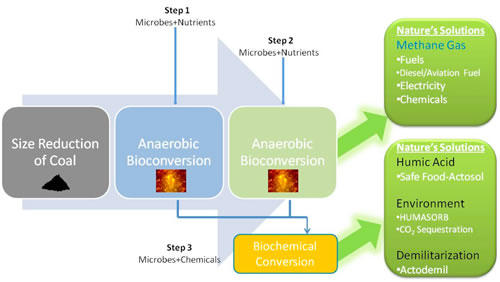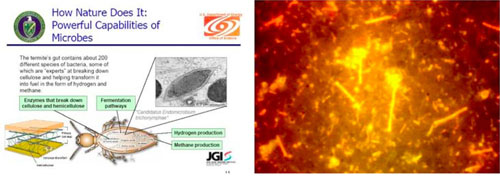|
|
|||
 |
| humics 101 | ||
Humic substances are a black to brown, highly functionalized carbon-rich macro-molecule. Bioconversion is accomplished by adapting micro-organisms (derived from termites) to coal in the presence of other appropriate nutrient components. Bioconversion is achieved in a three-step process. First, in the hydrolytic and fermentation process, microbes convert the coal into volatile organic liquids. Second, the liquid, along with gases produced, are contacted with methane producing microbes that hydrogenate the acetate and CO2 into methane. Third, the methane is then separated and unconverted residual coal residue is converted into humic acid for formulating into agricultural and environmental products. Humic substances are naturally occurring brown and black plant organic matter. They are comprised of humic acid, fulvic acid, and humin, which together are commonly referred to as “humus.” The importance of humus in agriculture has been known for centuries. Today, with the assistance of biotechnology, humic matter can play a major role in sequestering carbon. This averts the adverse consequences of climate change due to the excessive buildup of carbon dioxide (CO2) caused by the combustion of carbon fuels. Humic acids are the major component of humic substances. Humic acid is a highly functionalized carbon-rich macro-molecule. It contains more carbon than all living things. Humic acid exists in plants, soils, water, sewage biosolids and compost, and can be isolated from soft coals. Humic acid firmly retains water and is the buffer and matrix of many chemical and biochemical reactions in soils.
Termites are nature’s engineers. Our microbes have been bio-engineered from the gut of termites. Microbes were first discovered in 1675 and are very diverse. Microorganisms are vital to the environment, as they participate in the Earth's element cycles such as the carbon cycle and nitrogen cycle, as well as fulfilling other vital roles in virtually all ecosystems, including recycling other organisms' dead remains and waste products through decomposition.
Because it is a multifunctional material, humic acid has the ability to remove both inorganic and organic contaminants from wastewater. This approach has been used by the Company’s clients for more than 15 years to decontaminate and recycle wastewater for agricultural use in several countries where the only alternative is lifeless drought. |
Privacy Policy | © 2009 Humaxx, Inc. 14100 Park Meadow Drive, Suite 201, Chantilly, Virginia 20151-2217, USA | Terms of Use

